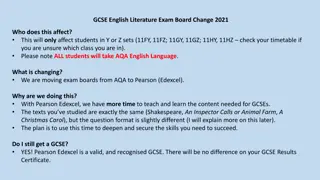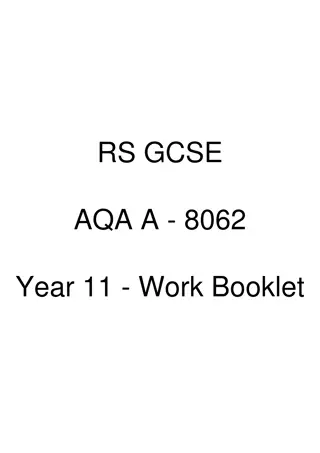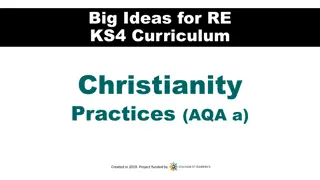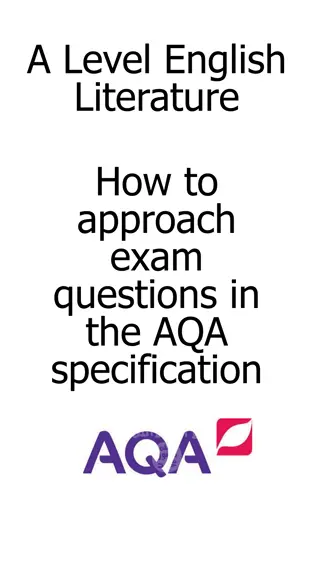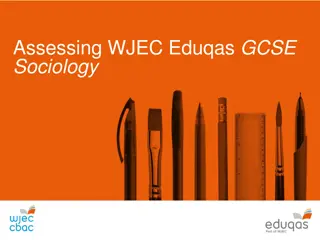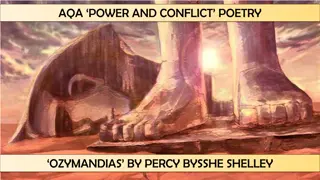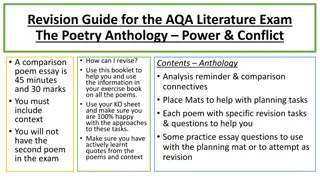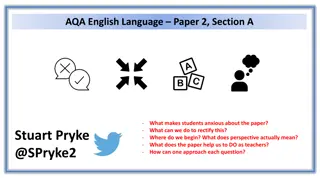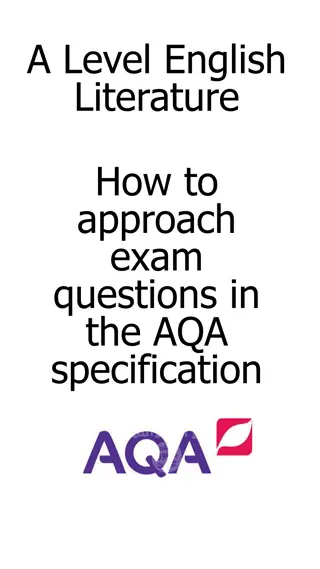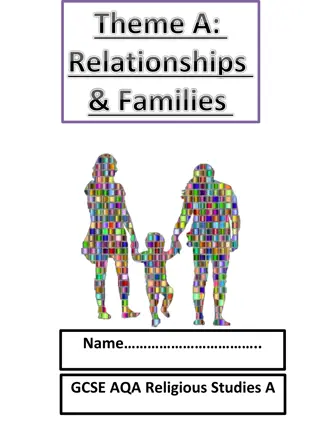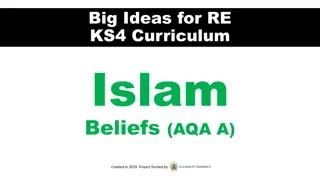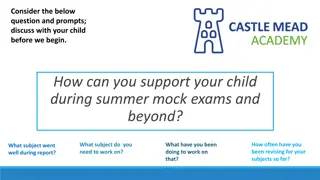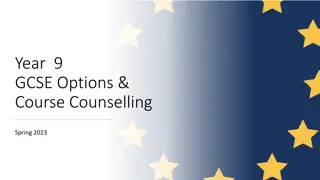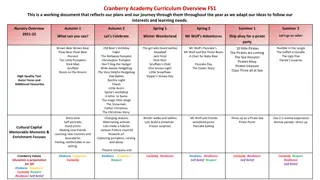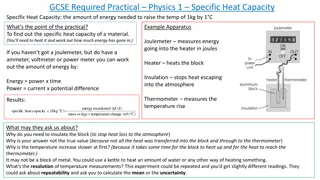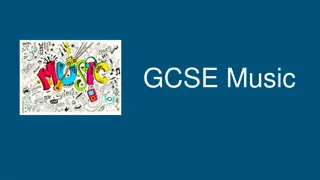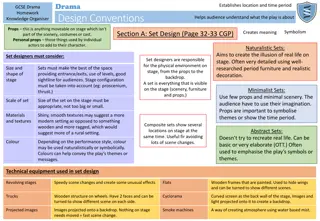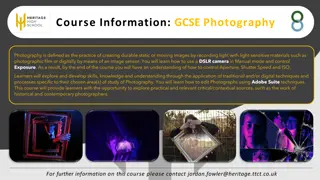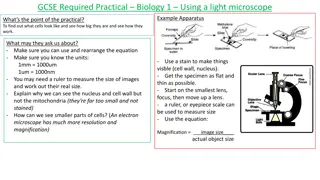AQA History GCSE Curriculum Overview and Options
Explore the AQA History GCSE curriculum including period studies, thematic studies, and depth studies with diverse topics such as America, Germany, Russia, Britain, and world conflicts. Choose from a range of historical periods and themes to study in depth, covering a wide array of topics from different eras and regions. Gain insights into historical events, societies, and individuals that have shaped the world we live in today.
Download Presentation

Please find below an Image/Link to download the presentation.
The content on the website is provided AS IS for your information and personal use only. It may not be sold, licensed, or shared on other websites without obtaining consent from the author. Download presentation by click this link. If you encounter any issues during the download, it is possible that the publisher has removed the file from their server.
E N D
Presentation Transcript
T E AC H I N G T H E AQA H I S TO RY G C S E H I S T O R I C A L A S S O C I A T I O N D I V E R S I T Y S T E E R I N G G R O U P E Q U A L I T Y , D I V E R S I T Y A N D I N C L U S I O N A T G C S E : A M E E T I N G O F R E P R E S E N T A T I V E S O F T H E H I S T O R Y C O M M U N I T Y 2 9 J U N E 2 0 2 2
Specification choices Paper 1: Understanding the modern world Section A: Period studies Choose one of the following options: AA America, 1840 1895: Expansion and consolidation AB Germany, 1890 1945: Democracy and dictatorship AC Russia, 1894 1945: Tsardom and communism AD America, 1920 1973: Opportunity and inequality Paper 2: Shaping the nation Section A: Thematic studies Choose one of the following options: AA Britain: Health and the people: c1000 to the present day AB Britain: Power and the people: c1170 to the present day AC Britain: Migration, empires and the people: c790 to the present day Section B: British depth studies including the historic environment Choose one of the following options: BA Norman England, c1066 c1100 BB Medieval England: The reign of Edward I, 1272 1307 BC Elizabethan England, c1568 1603 BD Restoration England, 1660 1685 Section B: Wider world depth studies Choose one of the following options: BA Conflict and tension: The First World War, 1894 1918 BB Conflict and tension: The inter-war years, 1918 1939 BC Conflict and tension between East and West, 1945 1972 BD Conflict and tension in Asia, 1950 1975 BE Conflict and tension in the Gulf and Afghanistan, 1990 2009
Specification choices Paper 1: Understanding the modern world Section A: Period studies Choose one of the following options: AA America, 1840 1895: Expansion and consolidation AB Germany, 1890 1945: Democracy and dictatorship AC Russia, 1894 1945: Tsardom and communism AD America, 1920 1973: Opportunity and inequality Paper 2: Shaping the nation Section A: Thematic studies Choose one of the following options: AA Britain: Health and the people: c1000 to the present day AB Britain: Power and the people: c1170 to the present day AC Britain: Migration, empires and the people: c790 to the present day Section B: British depth studies including the historic environment Choose one of the following options: BA Norman England, c1066 c1100 BB Medieval England: The reign of Edward I, 1272 1307 BC Elizabethan England, c1568 1603 BD Restoration England, 1660 1685 Section B: Wider world depth studies Choose one of the following options: BA Conflict and tension: The First World War, 1894 1918 BB Conflict and tension: The inter-war years, 1918 1939 BC Conflict and tension between East and West, 1945 1972 BD Conflict and tension in Asia, 1950 1975 BE Conflict and tension in the Gulf and Afghanistan, 1990 2009
Specification choices AB Germany, 1890 1945: Democracy and dictatorship BB Conflict and tension: The inter-war years, 1918 1939 AB Britain: Power and the people: c1170 to the present day BD Restoration England, 1660 1685
EQUALITY, DIVERSITY AND INCLUSION Positives Broad sweep of British history P&P does help with EDI theme Flexibility in choices Can tailor to intake Comes up to the present day Connects students to their past Assessment questions are about people Germany: Democracy and dictatorship Challenges Every decision narrows the focus Groups left silent Feeds misconceptions about EDI in the past At best is a cautionary tale Harms the message we are trying to send at Key Stage 3
H A R M S T H E M E S S A G E W E A R E T RY I N G TO S E N D AT K E Y S TA G E 3 The past is a diverse place Britain exists in a global context The past explains the present Understanding what historians do
NEW CURRICULUM Year 7 What was it like to be in Year 7 60 years ago? Year 8 How has the story of the African empires been told? What do artefacts tell us about Anglo-Saxon England? To what extent did the Norman Conquest change England? How powerful were medieval monarchs? What can portraits tell us about the changing roles of women, 1100 1600? What did you find on the Silk Road? Why did the Reformation survive the 1500s? How did Miranda Kaufmann uncover the hidden lives of Black Tudors? To what extent was the world turned upside-down in the seventeenth century? Should England have industrialised? Who was responsible for the abolition of the slave trade? How much did the British public know about the front? How did women protest for equality in the twentieth century? How typical was the experience of Clifford Spencer? (WWII) How does Britain s imperial legacy affect us today? How has the Holocaust been remembered? How much did Mao Zedong improve the lives of people in China? How has human history changed the environment? What is the future of history?
NEW CURRICULUM Year 7 What was it like to be in Year 7 60 years ago? Year 8 How has the story of the African empires been told? What do artefacts tell us about Anglo-Saxon England? To what extent did the Norman Conquest change England? Who was responsible for the abolition of the slave trade? How much did the British public know about the front? How powerful were medieval monarchs? What can portraits tell us about the changing roles of women, 1100 1600? What did you find on the Silk Road? How did women protest for equality in the twentieth century? How typical was the experience of Clifford Spencer? (WWII) Why did the Reformation survive the 1500s? How does Britain s imperial legacy affect us today? How did Miranda Kaufmann uncover the hidden lives of Black Tudors? To what extent was the world turned upside-down in the seventeenth century? Should England have industrialised? How has the Holocaust been remembered? How much did Mao Zedong improve the lives of people in China? Why does the story of nutmeg matter so much? What is the future of history?
Key Stage 4 Key Stage 3 Key Stage 5 BB Conflict and tension: The inter- war years, 1918 1939 1C: The Tudors History every story AB Germany, 1890 1945: Democracy and dictatorship The past is a diverse place Britain exists in a global context 2Q: USA American Dream The past explains the present AB Britain: Power and the people, c1170 to the present day Understanding what historians do Free choice NEA BD Restoration England, 1660 1685
Power and the people Power & Men Power & Women Power & Christian Britons Power & Black Britons Power & Asian Britons Power & Disabled Britons Power & LGBTQ+ Britons Power & European Britons This thematic study will enable students to gain an understanding of the development of the relationship between the citizen and the state in Britain over a long period of time. It considers the causes, scale, nature and consequences of protest for that relationship. By charting the journey from feudalism and serfdom to democracy and equality, it reveals how, in different periods, the state responds to challenges to its authority and their impact. It allows students to construct an understanding of the rights and responsibilities of the citizen.
A D D I N G E Q U A L I T Y, D I V E R S I T Y A N D I N C L U S I O N T O O U R S P E C I F I C AT I O N BB Conflict and tension: The inter- war years, 1918 1939 AB Britain: Power and the people, c1170 to the present day AB Germany, 1890 1945: Democracy and dictatorship BD Restoration England, 1660 1685
Diverse voices Part one: Challenging authority and feudalism Constraints on kingship: the barons dissatisfaction with King John s rule and its resolution; Magna Carta, its terms and its short- and long-term impact. The origins of Parliament: issues between King Henry III and his barons; the role of Simon de Montfort; the Provisions of Oxford and the Parliament of 1265 and their short- and long-term impact. Medieval revolt and royal authority: the social, economic and political causes of the Peasants Revolt; actions by rebels and government; impact of the Peasants Revolt. Part two: Challenging royal authority Popular uprisings against the Crown: the social, economic, religious and political causes of the Pilgrimage of Grace; the implications for royal authority; Henry VIII and his government s reaction and the impact of the uprising. Divine Right and parliamentary authority: the causes of the English Revolution; the New Model Army and the development of political radicalism during the Civil War era; the short- and long-term impact of the English Revolution, including the significance of the trial and execution of Charles I, and Oliver Cromwell and the Commonwealth. Royal authority and the right to representation: the causes of the American Revolution, including the relationship between the government and people; impact and significance of the American Revolution. Part three: Reform and reformers The extension of the franchise: radical protest; the Great Reform Act, causes and impact, including further reform; Chartism, causes, actions and impact. Protest and change: campaigning groups and their methods and impact, including the anti-slavery movement; the Anti-Corn Law League; factory reformers; social reformers. Workers movements: the development of trade unionism and its impact, including Grand National Consolidation Trades Union (GNCTU), Tolpuddle Martyrs, New Model Unions and new unionism, including the match girls and dockers strikes. Part four: Equality and rights Women s rights: the campaign for women s suffrage, reasons, methods and responses; role of individuals, including the Pankhursts; the reasons for the extension of the franchise and its impact; progress towards equality in the second half of the twentieth century. Workers rights: the General Strike (1926), actions, reactions and impact; trade union reform in the late twentieth century. Minority rights: the development of multi-racial society since the Second World War; discrimination, protest and reform; the Brixton Riots and their impact, including the Scarman Report. Women and Magna Carta Eleanor De Montfort Johanna Ferrour Africans in the ECW Jane Whorwood John Dyott Nanye-hi aka Nancy Ward William Cuffy Annie Knight Women of Tolpuddle Kitty Marion Sophie Duleep Singh Rosa May Billinghurst Lesbian and gays support the miners Diane Abbott
Year Source (8) Significance (8) Similarity (8) 16-marker Sample 1 Cromwell Explain the significance of the signing of the Magna Carta in the development of the rights of the British people Has religion been the main factor in causing protest in Britain since medieval times? Explain two ways in which the Peasants Revolt and the campaign for the People s Charter were similar Sample 2 Votes for women Explain the significance of the trial and execution of Charles I for Explain two ways in which the campaigns for workers rights in the nineteenth century and protests for the rights of ethnic minorities in the twentieth century were similar Has war and violence been the main way in which royal authority and governments have been challenged? royal authority 2018 Chartism Explain the significance of the American Revolution Compare the Tolpuddle Martyrs with the people involved in the General Strike of 1926 Has the role of the individual been the main factor in promoting people s rights in Britain? 2019 Pilgrimage of Grace Explain the significance of the General Strike Has war and violence been the main factor in the development of Parliament? Compare the Peasants Revolt with trade unionism in the nineteenth century 2020 Votes for women Explain the significance of the Great Reform Act Explain two ways in which Simon de Montfort and Oliver Cromwell were similar Have economic factors been the main cause of protest in Britain? 2021 Charles I Explain the significance of the Provisions of Oxford and the Parliament of 1265 Has the government been the main factor in improving people s rights in Britain? Explain two ways in which the Peasants Revolt and the American Revolution were similar 2022 Tolpuddle Martyrs Explain the significance of the Brixton Riots Explain TWO WAYS in which the Magna Carta and the Great Reform Act were similar Have ideas, such as equality and democracy, been the main reason for protest in Britain?
Year Source (8) Significance (8) Similarity (8) 16-marker Sample 1 Cromwell Explain the significance of the signing of the Magna Carta in the development of the rights of the British people Has religion been the main factor in causing protest in Britain since Medieval times? Explain two ways in which the Peasants Revolt and the campaign for the People s Charter were similar Sample 2 Votes for women Explain the significance of the trial and execution of Charles I for Explain two ways in which the campaigns for workers rights in the nineteenth century and protests for the rights of ethnic minorities in the twentieth century were similar Has war and violence been the main way in which royal authority and governments have been challenged? royal authority 2018 Chartism Explain the significance of the American Revolution Compare the Tolpuddle Martyrs with the people involved in the General Strike of 1926 Has the role of the individual been the main factor in promoting people s rights in Britain? 2019 Pilgrimage of Grace Explain the significance of the General Strike Has war and violence been the main factor in the development of Parliament? Compare the Peasants Revolt with trade unionism in the nineteenth century 2020 Votes for women Explain the significance of the Great Reform Act Explain two ways in which Simon de Montfort and Oliver Cromwell were similar Have economic factors been the main cause of protest in Britain? 2021 Charles I Explain the significance of the Provisions of Oxford and the Parliament of 1265 Has the government been the main factor in improving people s rights in Britain? Explain two ways in which the Peasants Revolt and the American Revolution were similar 2022 Tolpuddle Martyrs Explain the significance of the Brixton Riots Explain TWO WAYS in which the Magna Carta and the Great Reform Act were similar Have ideas, such as equality and democracy, been the main reason for protest in Britain?
Year Source (8) Significance (8) Similarity (8) 16-marker Sample 1 Cromwell Explain the significance of the signing of the Magna Carta in the development of the rights of the British people Has religion been the main factor in causing protest in Britain since Medieval times? Explain two ways in which the Peasants Revolt and the campaign for the People s Charter were similar Sample 2 Votes for women Explain the significance of the trial and execution of Charles I for Explain two ways in which the campaigns for workers rights in the nineteenth century and protests for the rights of ethnic minorities in the twentieth century were similar Has war and violence been the main way in which royal authority and governments have been challenged? royal authority 2018 Chartism Explain the significance of the American Revolution Compare the Tolpuddle Martyrs with the people involved in the General Strike of 1926 Has the role of the individual been the main factor in promoting people s rights in Britain? 2019 Pilgrimage of Grace Explain the significance of the General Strike Has war and violence been the main factor in the development of Parliament? Compare the Peasants Revolt with trade unionism in the nineteenth century 2020 Votes for women Explain the significance of the Great Reform Act Explain two ways in which Simon de Montfort and Oliver Cromwell were similar Have economic factors been the main cause of protest in Britain? 2021 Charles I Explain the significance of the Provisions of Oxford and the Parliament of 1265 Has the government been the main factor in improving people s rights in Britain? Explain two ways in which the Peasants Revolt and the American Revolution were similar 2022 Tolpuddle Martyrs Explain the significance of the Brixton Riots Explain TWO WAYS in which the Magna Carta and the Great Reform Act were similar Have ideas, such as equality and democracy, been the main reason for protest in Britain?
Diversity is in the specification. We leave silences based on our choices. You can put diverse voices back in. The utility of these diverse voices for the exam is questionable. C O N C L U S I O N



